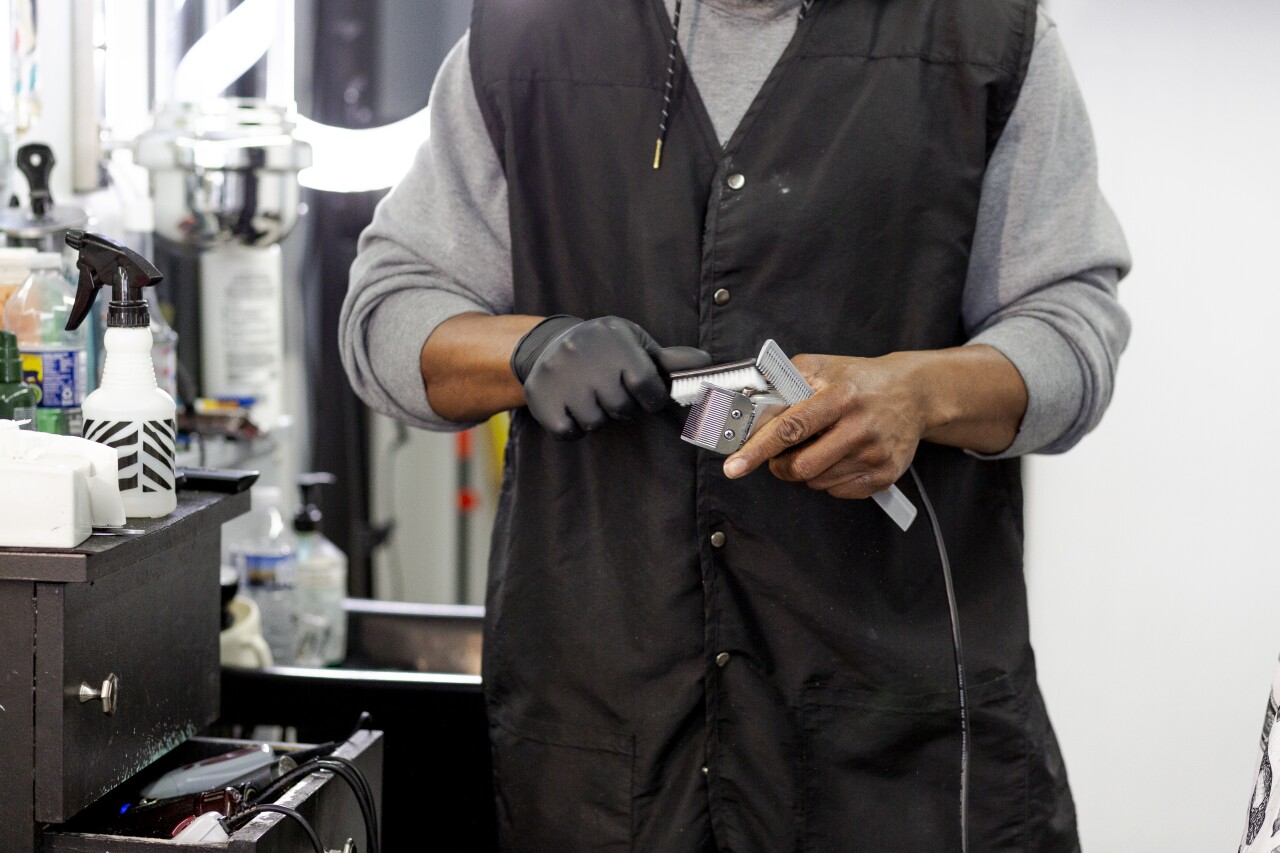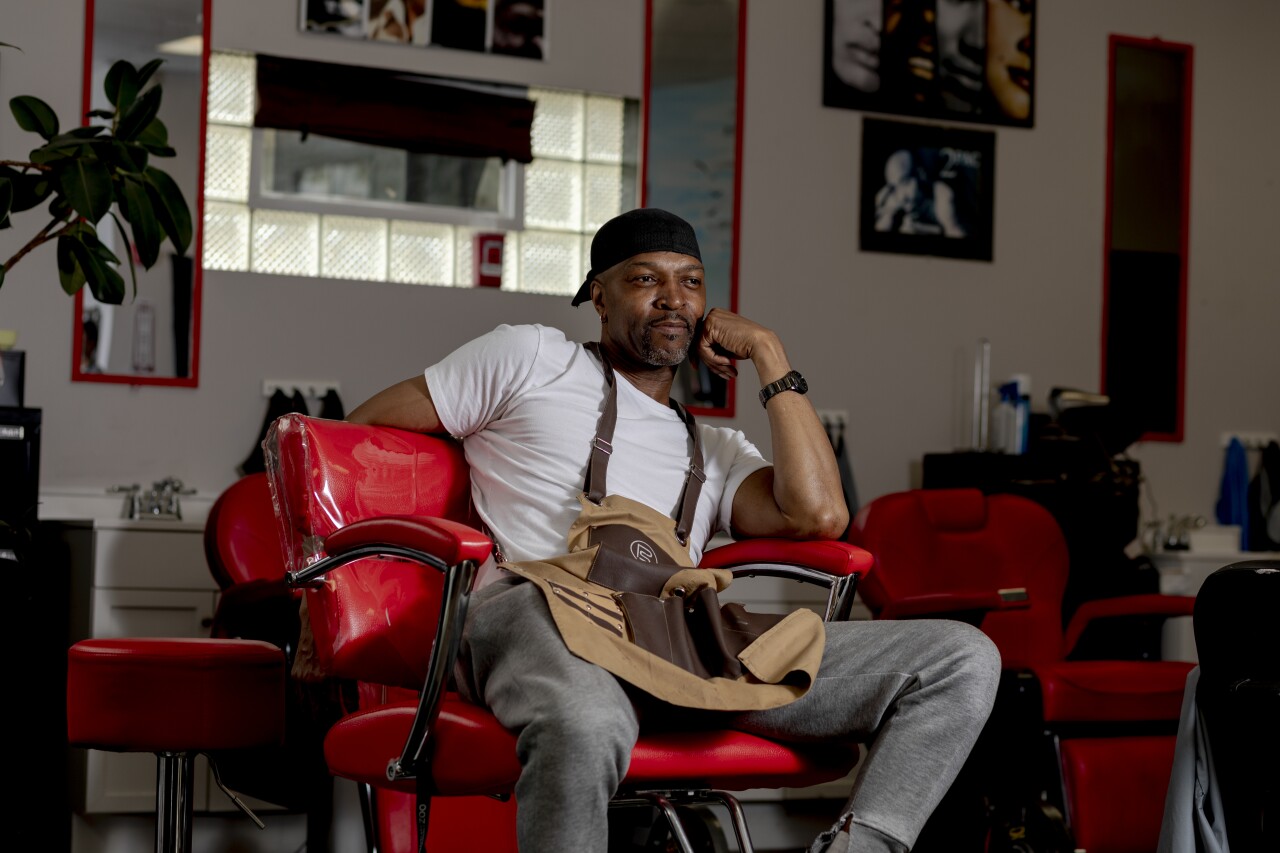This article was published in partnership with The Marshall Project, a nonprofit news organization covering the U.S. criminal justice system. Sign up for their newsletters, and follow them on Twitter, Instagram and Facebook.
Promise Stewart and Santonio Ford met 18 years ago, on a prison bus headed to a halfway house in Cleveland. They noticed each other’s edge-ups and began a conversation that changed their lives.
Stewart, now 58, had just served two years at the Mansfield Correctional Institution on drug charges. Before he was incarcerated, he operated a barbershop in Cleveland’s Detroit-Shoreway neighborhood.
Ford, now 48, was finishing a three-year sentence at the Richland Correctional Institution, less than a mile away, on a felonious assault charge. He wanted to become a barber as well, and was several credits shy of completing a state certification program at the prison before his release.
During the 90-minute drive to the Harbor Light Complex transitional facility, Stewart and Ford talked about using the barber skills they learned in their teens as a way to support themselves and stay out of trouble for good.
They shared ideas. They shared techniques. A brotherhood formed.
And they were able to beat the odds and land state-issued barber licenses, despite the many legal obstacles because of their convictions.
Ford and Stewart are just two of the nearly2,000 people who returnto Cuyahoga County each year from Ohio prisons and local jails, according to the Ohio Department of Rehabilitation and Correction. When formerly incarcerated people try to reintegrate into society, more than 1,600 laws and regulations often shut them out from employment, housing and educational opportunities.
Some of those limitations may soon change in Ohio and beyond. A bipartisan bill moving through the state Legislature would expand access to public housing and some rental properties for people who have been released. Also this year, President Joe Biden designated April as “Second Chance Month” to recognize formerly incarcerated people and reentry programs. The Biden Administration directed the federal Small Business Administration to offer more business start-up loans to applicants with criminal records.
“When you put somebody in jail, you’re punishing them right then and there,” Stewart said. “So, when they do their time, you should not punish them more when they are supposed to be free.”

More than 1,600 potential consequences
An obscure two-word term is one of the greatest obstacles a person with a record will face.
“Collateral consequences” are laws or policies that prevent people with criminal records from obtaining employment, certifications, education and more. The National Inventory of Collateral Consequences of Conviction listed over 1,600 consequences that bar such access due to a previous conviction stemming from 1,250 violations in Ohio on its database.
For instance, a person with a sexual offense on their record would be barred from working at a nursing home or hospital. And a person with any felony would also be ineligible to be a driving instructor or to apply for a license to operate an amusement ride.
Every year, people who have been incarcerated lose more than $55 billion in potential income, according to a 2020 report by The Brennan Center for Justice. The report states that 1 in 5 Americans have a criminal record, and that people who are imprisoned early in their lives earn about half as much annually as people who do not have criminal records.
Steve Lopez, an associate professor of sociology at The Ohio State University, said that most jobs available for the formerly incarcerated don’t pay a living wage that would support a family — or even the ability to afford reliable transportation if the job was not close to their home. What’s more, a 2022 study Lopez co-authored found that steady employment can keep people from returning to prison.

“I see employment as a necessary, but not a sufficient, condition,” Lopez said. “Employment by itself is not a panacea for helping someone change their life … they have to figure out why they want to change their life.”
Entrepreneurship might appear to be an easier path, but even that is riddled with obstacles, said Ronald Crosby, an organizer with Building Freedom Ohio, an organization that works to restore rights for formerly incarcerated people.
“Being a barber is an honorable profession, but if you have a felony, it’s hard to get loans from banks or leases from landlords. A lot of people end up having to put the business in someone else’s name,” Crosby said. “Ownership and entrepreneurship move the needle. … You don’t have to stress and strain about how you can provide for your family.”
Stewart and Ford earned their certifications at different times and worked multiple side jobs — some lasted just a few days — to earn enough money to pay for barbering college. They had to find jobs that didn’t conflict with their post-release requirements and that also allowed them to complete the apprentice hours needed to earn their certifications.
“You have to fully commit,” Ford said. “I had to get a third-shift job so I could go to school from 9 to 5.”
Stewart said he wanted the barbering license because it was important for him to be his own boss. Barbering is a reliable way to earn income and is a service people will always need, Stewart said.
“With barbering, that is a good occupation because ain’t gonna be no computers or robots that can do that,” Stewart said.



Changing the law
In 2012, former Ohio Gov. John Kasich, a Republican, signed a bipartisan law to ease restrictions for earning state licenses and certifications in skilled trades. State corrections officials approve applications by people in prison or those who were previously incarcerated, and judges award work-readiness certificates for them to present to prospective employers.
The program initially issued certificates for jobs that included barbering and cosmetology, real estate, nursing and social work. It has now expanded to include aviation, casino gaming, clinical psychology, medicine, case management and even law enforcement.
Even though 82% of the applications reviewed by Ohio courts over a nine-year period were approved, according to the Ohio Department of Rehabilitation and Correction, few completed the process. In 2021, just 17 certifications out of 22 court hearings were issued in Cuyahoga County, which points to a problem justice reform advocates say needs to be fixed — the certification process remains relatively unknown to many employers and potential applicants.
As for housing, earlier this year, state Rep. Bill Seitz, R-Cincinnati, and Ohio Rep. Latyna Humphrey, D-Columbus, introduced a bill that would expand access to publicly funded housing for people who have criminal records. The bill is before the House Criminal Justice Committee.
Seitz, who serves on the committee, said that although the legislation may not solve every obstacle a formerly incarcerated person may experience, it can help put them on a pathway to earn a steady paycheck, build a credit history, and put themselves in a position to advance.
“People can change, and they do change, and having learned their lesson…go out and become role models for other people to do the same thing,” Seitz said.
‘People deserve a second chance’
From 2005 to 2018, Stewart owned Zeke’s Barber Shop on Detroit Avenue. His family ran the business — which also included a nail salon — while he was incarcerated. Ford joined the shop in 2006 after he was released from the halfway house. He eventually became the shop’s manager and lead barber.
Zeke’s was an unofficial community center and resource for people who returned from prison. They could get advice and free haircuts before they saw their loved ones, a fresh shave, and sometimes, gently used professional clothes before a job interview. The shop was also a place where single mothers could bring their sons to get mentorship from other men through daily chess battles, or to have conversations about making good choices. It had the feel of a family living room rather than a barbershop.
Stewart said when he was released from the halfway house, he knew that he wanted Ford to be one of his partners.
“When I told Tone I had a barber shop, I don’t think he really believed me at first,” Stewart said. “And I get it. People will tell you all kinds of stories in the joint.”
Ford, Stewart and other barbers in the shop would often go the extra mile to help formerly incarcerated people who entered the shop.
“We all understood the struggle,” said James “BJ” Moore, 48, a former barber at Zeke’s who now works as a delivery driver and part-time barber. “We just tried to do our part, in our own little way, because people deserve second chances.”
Nelson Beckford, 51, a sales executive and former customer at Zeke’s, said Ford and Stewart “rewrote their stories” and have used their experiences to help others.
To be locked into only working for someone else simply “clips wings” for formerly incarcerated people, he said.


Fighting ‘the label’
Stewart closed his Detroit-Shoreway shop in 2018 after a rent increase. Many of the barbers went back to working side jobs or transitioned to other shops in the city. He reopened the shop in 2020 at a new location in Old Brooklyn.
The abrupt closure motivated Ford to accomplish his dream of running his own shop.
He worked as a private barber through the COVID-19 pandemic, and saved enough money to open Authentic Kutz, a barber shop in the city’s Bellaire-Puritas neighborhood, in 2021. The process wasn’t easy. Ford said he was denied several bank loans due to his record.
“People put a label on you and want you to wear it forever, no matter how much you have changed,” said Ford, who grew up in foster care and in group homes throughout Cleveland. “I remember this one time I did everything they [loan officers] said to do and was still denied.”
The bond Stewart and Ford formed during the bus ride has evolved from friendship, to partnership, to entrepreneurship. Most importantly, it allowed both men to be present in their children’s lives. They’ve been able to watch some of them graduate from college and start their own families. The men, who now both have gray in their beards, are also doting grandfathers — something both men said they thought they would never see.
“I cried. I was discouraged,” Ford said. “But I kept going until I was able to make my own way, and some good people helped me along the way. You have to keep going.”

Local Reentry Assistance Organizations
The below county and nonprofit organizations are a few of the many agencies that provide information, legal services and job opportunities for the formerly incarcerated. For a more expanded list, visit the Cuyahoga County Office of Reentry website.
Cuyahoga County Office of Reentry: The county-run office partners with community agencies throughout Greater Cleveland to coordinate services and educational events for formerly incarcerated people. (216) 881-5554
Building Freedom Ohio: The organization provides and promotes leadership, organizational and strategic planning workshops for formerly incarcerated people. The founders of the organization, and many of the group’s members, were once incarcerated in Ohio Department of Rehabilitation and Correction facilities. (216) 417-2743 info@ohoorganizing.org
The Legal Aid Society of Cleveland: Provides free legal services for individuals with limited resources. 888-817-3777
Towards Employment: The agency is a workforce development organization that connects people to employment opportunities in Northeast Ohio. (216) 696-5750










